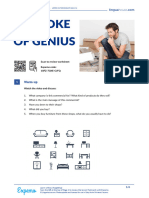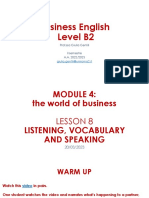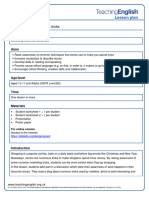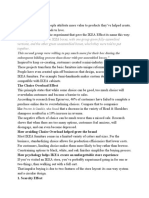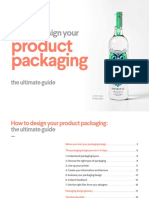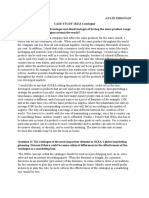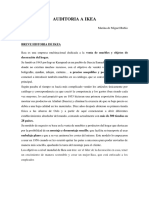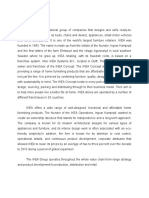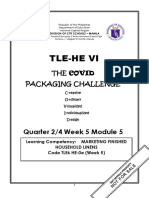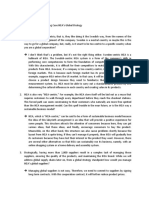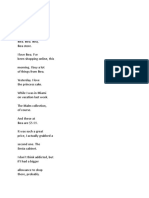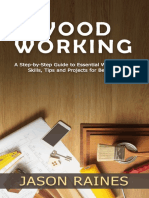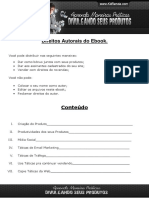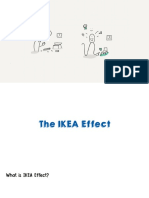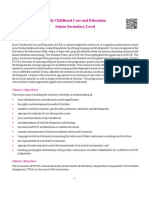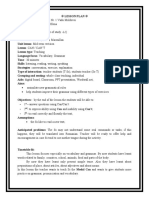A Stroke of Genious - Student
A Stroke of Genious - Student
Uploaded by
João Pedro M GuimarãesCopyright:
Available Formats
A Stroke of Genious - Student
A Stroke of Genious - Student
Uploaded by
João Pedro M GuimarãesOriginal Title
Copyright
Available Formats
Share this document
Did you find this document useful?
Is this content inappropriate?
Copyright:
Available Formats
A Stroke of Genious - Student
A Stroke of Genious - Student
Uploaded by
João Pedro M GuimarãesCopyright:
Available Formats
BUSINESS ENGLISH · BUSINESS ISSUES · UPPER-INTERMEDIATE (B2-C1)
A STROKE
OF GENIUS
QrrkoD Scan to review worksheet
Expemo code:
122I-7788-IB7T
1 Warm-up
Watch the video and discuss:
1. What company is this commercial for? What kind of products do they sell?
2. What is the main message of this commercial?
3. Have you been to their shops?
4. What did you buy?
5. When you buy furniture from these shops, what do you usually have to do?
FOOOOTERRIGHT Learn without forgetting! 1/5
Scan the QR at the top of Page 1 to review the lesson flashcards with Expemo.
© Linguahouse.com. Photocopiable and licensed for use in Joao Guimaraes's lessons.
UPPER-INTERMEDIATE (B2-C1)
A STROKE OF GENIUS
2 Reading (introduction)
Read the title and introduction of the article on the next page, using the glossary to help.
• stationery = pens and papers; things used for writing, study or office work
• stockings = a type of clothing that women wore to cover their feet and legs before tights were
invented
• flat-pack furniture = furniture that you have to assemble, or build, yourself
• shop layout = the plan of a shop, the way things are organised and displayed
3 Before you read
Before you read the rest of the article, look at these phrases from the text. Predict which section of
the text they relate to, and write A (= flat-pack furniture) or B (= a shop layout that encourages people
to buy more products). Then read the text to check your ideas.
1. ... you want to pick it up ...
2. ... feel proud of their achievement ...
3. ... aspects of cost and the practicality of shipping.
4. The act of touching products ...
5. ... you often can’t see what is coming next ...
6. ... putting something together ...
7. ... thinking you were only buying a few items ...
8. ... you can’t see around the next corner ...
FOOOOTERLEFT Learn without forgetting! 2/5
Scan the QR at the top of Page 1 to review the lesson flashcards with Expemo.
© Linguahouse.com. Photocopiable and licensed for use in Joao Guimaraes's lessons.
UPPER-INTERMEDIATE (B2-C1)
A STROKE OF GENIUS
The Ikea effect
How Ingvar Kamprad’s company changed the way we shop
1.
On January 27 2018, Ingvar Kamprad, who started 6.
Round and round in circles
Ikea as a teenager, died at the age of 91. Starting The layout of the Ikea stores has also paved the
with stationery and stockings, he had built one of the way for a more creative way of thinking about how
world’s biggest furniture companies. And the way he to guide shoppers. If you have ever visited one of
did it has revolutionised how retailers operate. its huge warehouse stores, you may have gone in
2.
There are two features of modern life that we have thinking you were only buying a few items, to find
Ikea to thank for: flat-pack furniture and a shop yourself coming out of the store with a trolley full of
layout that gets you buying more of its products than things. This is because of its circular design and one
you initially intended to. Both are principles that a way system.
number of other companies have copied. 7.
This design means you often can’t see what is coming
3.
Ikea first brought out its flat-pack furniture in the next and fear you’ll miss something you need if you
1950s. Whether you love or loathe this concept, don’t continue all the way along the path. There
it was a stroke of genius and an effective way are potential escape points throughout the store, but
of making customers value the brand. There are that would mean that you will miss several sections.
the obvious aspects of cost and the practicality Consumers are rarely prepared to take that risk.
of shipping. But flat-pack furniture also has an 8.
Because you know it may be tricky to go back for a
important subconscious influence on consumers. particular item later on, you want to pick it up when
4.
When Ikea stopped selling furniture that was already you see it and put it in your big trolley. This ensures
assembled, it was probably unaware of how this that the customer touches the product, which in turn
would influence its consumers. Scientists have since again generates a psychological sense of ownership
managed to identify exactly why consumers simply and decreases the chance that it will be put down
can’t get enough of building their own furniture. before you get to the tills.
The act of touching products while assembling the 9.
The fact that you can’t see around the next corner
furniture can increase your perceived value of the also creates a sense of mystery. Environments
product. In addition, the more effort a consumer has perceived to be mysterious usually generate a
to put into building something the more they like it – stronger liking and so encourage shoppers to keep
a winning formula. walking through the store. And the more you do
5.
Tests have shown that the actual act of putting this, the more likely you are to buy something –
something together (so that it becomes a complete especially all the smaller items on display such as
object) generates a much more positive perception candles, napkins and picture frames as they seem
of that object than purchasing it in a completed cheap compared to the larger more expensive items.
form. This is known as the Ikea effect. Furthermore, 10.
Ikea’s creative ability to influence the subconscious
touch itself is associated with emotion. This means of consumers is undoubtedly a big part of its success
that when we touch something, the emotive part – and also why it’s been copied by many other
of our brain is activated and we experience a close companies. Even though Ingvar Kamprad is no longer
connection with the product. Touch creates feelings with us, Ikea has inherited from him a way of thinking
of ownership and increases the perceived value of outside of the box to communicate with consumers.
items. We feel proud of our achievement and It will be interesting to see what follows next.
experience feelings of being closely connected to the Adapted from: The Conversation by Sascha Steinbach,
assembled item.
January 30, 2018
FOOOOTERRIGHT Learn without forgetting! 3/5
Scan the QR at the top of Page 1 to review the lesson flashcards with Expemo.
© Linguahouse.com. Photocopiable and licensed for use in Joao Guimaraes's lessons.
UPPER-INTERMEDIATE (B2-C1)
A STROKE OF GENIUS
4 General vocabulary in the text
Read the text again to find the words in bold. Use the context of the article to guess what they mean.
Then check your ideas and the pronunciation in a dictionary.
1. loathe (verb)
2. subconscious (adj.)
3. ownership (noun)
4. warehouse (noun)
5. trolley (noun)
6. tricky (adj.)
7. tills (noun - plural)
8. mystery (noun)
5 Business vocabulary in the text
Match these phrases from the article to their meaning.
1. a stroke of genius a. a really intelligent idea
2. can’t get enough of b. how important we think something is
3. perceived value c. original and creative thoughts
4. thinking outside of the d. want to do something more and more
box
How could you translate these phrases into your language? Translate the idea, not each word.
6 Grammar: The more ... the more
Read the sentences below from the text. They follow the same pattern. What is the relationship
between Part 1 and Part 2 of the sentence? Choose the best explanation:
a. time sequence
b. cause and effect
c. contrasting points
d. additional points
Part 1 Part 2
The more effort a consumer has to put into the more they like it.
building something,
The more you walk through the store, the more likely you are to buy something.
FOOOOTERLEFT Learn without forgetting! 4/5
Scan the QR at the top of Page 1 to review the lesson flashcards with Expemo.
© Linguahouse.com. Photocopiable and licensed for use in Joao Guimaraes's lessons.
UPPER-INTERMEDIATE (B2-C1)
A STROKE OF GENIUS
Notice the comparatives in both Part 1 and Part 2. We can also express the same ideas as a conditional
sentence, for example:
If/when a consumer has to put some effort into building something, they like it more.
If/when you walk through the store for a long time, you are more likely to buy something.
Complete these sentences with your own ideas, expressing cause and effect. Use comparative forms
(more/better/less/etc) in the second part, as in the model.
1. The more I study, ...
2. The more I exercise, ...
3. The more people recycle, ...
4. The more money you spend on food, ...
5. The more time you waste on, ...
7 Summary
This word cloud comes from the article. Using these words, or forms of these words, summarise the
main points.
Homework: write a 50-word summary of the text, using these words.
FOOOOTERRIGHT Learn without forgetting! 5/5
Scan the QR at the top of Page 1 to review the lesson flashcards with Expemo.
© Linguahouse.com. Photocopiable and licensed for use in Joao Guimaraes's lessons.
You might also like
- 321 Five Day Reading Plans MelodyDocument5 pages321 Five Day Reading Plans Melodyapi-708910591No ratings yet
- Building New Boxes WorkbookDocument8 pagesBuilding New Boxes WorkbookSneha100% (2)
- The User's Journey: Storymapping Products That People LoveFrom EverandThe User's Journey: Storymapping Products That People LoveRating: 3.5 out of 5 stars3.5/5 (8)
- So 2ND Ed Uin Read Extra U1 PDFDocument2 pagesSo 2ND Ed Uin Read Extra U1 PDFVasylyna FitsykNo ratings yet
- 413 17 - Speakout Upper-Intermediate 2nd Reading Amp Listening Extra 2016 AudioDocument20 pages413 17 - Speakout Upper-Intermediate 2nd Reading Amp Listening Extra 2016 AudioСветлана Червяковская0% (1)
- Case Study - USADocument3 pagesCase Study - USATạNgọcPhươngThảo100% (1)
- Subject-Centered DesignDocument3 pagesSubject-Centered DesignJohn Daniel Paulino GumbanNo ratings yet
- Visually Impaired PresentationDocument11 pagesVisually Impaired PresentationRajesh SoniNo ratings yet
- A Stroke of Genius British English Student Ver2Document6 pagesA Stroke of Genius British English Student Ver2Mantė GudavičiūtėNo ratings yet
- A Stroke of Genius British English Student Ver2Document6 pagesA Stroke of Genius British English Student Ver2JustynaNo ratings yet
- A Stroke of Genius British English Teacher Ver2Document8 pagesA Stroke of Genius British English Teacher Ver2МарияNo ratings yet
- The Ikea Effect British English Upper Intermediate Advanced Group PDFDocument4 pagesThe Ikea Effect British English Upper Intermediate Advanced Group PDFМарина ПевцеваNo ratings yet
- The Ikea Effect Luz ValeriaDocument3 pagesThe Ikea Effect Luz ValeriaMario José Elvir MaldonadoNo ratings yet
- The Ikea Effect 2Document2 pagesThe Ikea Effect 2giorgia98faiellaNo ratings yet
- IKEA Case #Example1Document3 pagesIKEA Case #Example1송주영No ratings yet
- Business English Level B2: Prof - Ssa Giulia Gentili II Semestre A.A. 2022/2023Document11 pagesBusiness English Level B2: Prof - Ssa Giulia Gentili II Semestre A.A. 2022/2023Vincenzo Di PintoNo ratings yet
- Reading Lesson Plan (Ikea's Marketing Success)Document6 pagesReading Lesson Plan (Ikea's Marketing Success)Emx BeyNo ratings yet
- 02 Product Packaging ProcessDocument14 pages02 Product Packaging ProcessDan JamesNo ratings yet
- Shopping Tricks LPDocument5 pagesShopping Tricks LPTrần Phương ThảoNo ratings yet
- How Ikea Tricks You Into Buying More StuffDocument10 pagesHow Ikea Tricks You Into Buying More StuffindiolandNo ratings yet
- Cot2 Tle Simple ProductsDocument25 pagesCot2 Tle Simple ProductsHN CAHILSOT CESNo ratings yet
- The IKEA EffectDocument4 pagesThe IKEA EffectSyed Danyal ShahNo ratings yet
- 0011 - Lesson 3. Improving HistoryDocument5 pages0011 - Lesson 3. Improving Historyahmed ibrahimNo ratings yet
- Writing Lesson Plan Template CAEP K-6 Standards Kayla Hershberger 2 GradeDocument10 pagesWriting Lesson Plan Template CAEP K-6 Standards Kayla Hershberger 2 Gradeapi-456999393No ratings yet
- (A) Components in The Sales Presentation ScriptDocument6 pages(A) Components in The Sales Presentation Scriptmicaella judelleNo ratings yet
- Dangerous Ideas: When Provocative Thinking Is Your Most Valuable AssetFrom EverandDangerous Ideas: When Provocative Thinking Is Your Most Valuable AssetRating: 3.5 out of 5 stars3.5/5 (4)
- How To Design Your: Product PackagingDocument22 pagesHow To Design Your: Product PackaginggrjusNo ratings yet
- Ayli̇n Erdoğan İkea Uğur CaseDocument1 pageAyli̇n Erdoğan İkea Uğur CaseAylin ErdoğanNo ratings yet
- C10BEYWT2SHALRSS0601Document26 pagesC10BEYWT2SHALRSS0601pacheco.ernesto777No ratings yet
- Perennial Seller: Memorization Booklet Ryan HolidayDocument26 pagesPerennial Seller: Memorization Booklet Ryan HolidayLuis CarlosNo ratings yet
- Module 3: Buy It!: Skill: ReadingDocument10 pagesModule 3: Buy It!: Skill: ReadingRinawati Mohd NawawiNo ratings yet
- Auditoria A Ikea 2Document7 pagesAuditoria A Ikea 2wv4cwpw9zbNo ratings yet
- OriginalDocument28 pagesOriginalMuntser AlmomaniNo ratings yet
- TLE ICT6 Module 1Document9 pagesTLE ICT6 Module 1kathleenjaneNo ratings yet
- IKEADocument7 pagesIKEAbazingaNo ratings yet
- TLE-HE 6 - Q2 - Mod5Document20 pagesTLE-HE 6 - Q2 - Mod5trishajilliene nacis0% (1)
- Thesis IkeaDocument7 pagesThesis IkeaAndrew Molina100% (2)
- Intellectual Property BookletDocument16 pagesIntellectual Property BookletLuis RodríguezNo ratings yet
- Products Ielts Speaking Part 2 3 British English StudentDocument3 pagesProducts Ielts Speaking Part 2 3 British English Studentcarlosrom9610No ratings yet
- A2 UNIT 4 Life Skills Video WorksheetDocument1 pageA2 UNIT 4 Life Skills Video WorksheetАлена СылтаубаеваNo ratings yet
- Closing Case IKEA's Global StrategyDocument1 pageClosing Case IKEA's Global StrategyBucin Youngblood100% (1)
- Student: Mariyah Arif, User Experience - IKEADocument3 pagesStudent: Mariyah Arif, User Experience - IKEAGaurang DesaiNo ratings yet
- IKEA Store LayoutDocument2 pagesIKEA Store Layoutmahimahiwase24No ratings yet
- Tóm Tắt Video Về IkeaDocument24 pagesTóm Tắt Video Về IkeaDas PoiNo ratings yet
- Shopping and Sales Tricks: Lesson PlanDocument2 pagesShopping and Sales Tricks: Lesson PlanYedraNo ratings yet
- Topic: WorksheetDocument2 pagesTopic: WorksheetСергій Анатолійович НікітінNo ratings yet
- The Ultimate Guide To Product Packaging Design - 99designsDocument34 pagesThe Ultimate Guide To Product Packaging Design - 99designsBagas AdamNo ratings yet
- Untitled DocumentDocument4 pagesUntitled DocumentofficialanagofelixNo ratings yet
- Year 9 - Product in A Tin - Week 1Document12 pagesYear 9 - Product in A Tin - Week 1Ella DGNo ratings yet
- 7 - Pitching An Idea - Vocabulary - Listening ComprehensionDocument3 pages7 - Pitching An Idea - Vocabulary - Listening ComprehensioninesfilmmakerNo ratings yet
- What Is The IKEA EffectDocument5 pagesWhat Is The IKEA EffectAntonio BaletaNo ratings yet
- How to Get Your Product to Market: A guide to design, manufacturing, marketing and sellingFrom EverandHow to Get Your Product to Market: A guide to design, manufacturing, marketing and sellingRating: 5 out of 5 stars5/5 (1)
- Woodworking A Step by Step Guide To Essential Woodworking Skills Tips and ProjectsDocument105 pagesWoodworking A Step by Step Guide To Essential Woodworking Skills Tips and ProjectsTomasthc Ait100% (1)
- 5 Types of Propaganda Lesson PlanDocument10 pages5 Types of Propaganda Lesson PlandianeserranNo ratings yet
- Week5 DLL Tle HeDocument12 pagesWeek5 DLL Tle Heailyn araizaNo ratings yet
- MODULE 3 - Business 101Document6 pagesMODULE 3 - Business 101emzthineNo ratings yet
- EbookDocument10 pagesEbookRonald MartinsNo ratings yet
- MM Report KidealDocument27 pagesMM Report Kidealtomasb-2000No ratings yet
- Ikea EffectDocument16 pagesIkea EffectRajat JainNo ratings yet
- Tle 6 Module 1 Week 1 3 1Document21 pagesTle 6 Module 1 Week 1 3 1KATHLENE CORPUSNo ratings yet
- KMU 1053 DesignRulesDocument24 pagesKMU 1053 DesignRulesAndy687420No ratings yet
- Curriculum (ECCE)Document9 pagesCurriculum (ECCE)aditya dubeyNo ratings yet
- UBD Template - Final UseDocument2 pagesUBD Template - Final UseraejengilNo ratings yet
- El 101 3a ValuesDocument19 pagesEl 101 3a ValuesJonas Landicho MagsinoNo ratings yet
- Quantifying Compensatory Strategies in Adults With and Without Diagnosed AutismDocument10 pagesQuantifying Compensatory Strategies in Adults With and Without Diagnosed AutismJULIANo ratings yet
- Understanding Disciplines and Subjects SeminarDocument27 pagesUnderstanding Disciplines and Subjects SeminarAshna C PhilipNo ratings yet
- Eng111 - Module 2 (Humss & Abm)Document11 pagesEng111 - Module 2 (Humss & Abm)Cluster 2, Cebu city, Josh C AgustinNo ratings yet
- Hawassa University College of Social Sciences: August 2022Document3 pagesHawassa University College of Social Sciences: August 2022Eyuel Nebiyu100% (1)
- 49,720, Text TypologyDocument11 pages49,720, Text TypologyRodrigo ZamoranoNo ratings yet
- Short-Term Course On Data Science 1 Aug-30 Sep 2022Document8 pagesShort-Term Course On Data Science 1 Aug-30 Sep 2022ndhrtdNo ratings yet
- Lesson Plan VDocument6 pagesLesson Plan VAdrian AndrasNo ratings yet
- CHAPTER 13 (How To Write Chapter 1 The Prob and Its Setting)Document9 pagesCHAPTER 13 (How To Write Chapter 1 The Prob and Its Setting)Kimberly Dazo100% (1)
- Imagination and Interpretation in Kant The Hermeneutical Import of The Critique of Judgment (Rudolf A. Makkreel) (Editado)Document199 pagesImagination and Interpretation in Kant The Hermeneutical Import of The Critique of Judgment (Rudolf A. Makkreel) (Editado)Juan Carlos CastroNo ratings yet
- Learning A Deep Neural Net Policy For End-to-End Control of Autonomous VehiclesDocument6 pagesLearning A Deep Neural Net Policy For End-to-End Control of Autonomous VehiclesAvinash KumarNo ratings yet
- The Book of StormsDocument101 pagesThe Book of Stormsjanutala100% (3)
- Module 4 5 6 Entrepreneurial MindDocument60 pagesModule 4 5 6 Entrepreneurial MindBettymae AndayaNo ratings yet
- 7318 17395 1 SMDocument9 pages7318 17395 1 SMPavi ArulNo ratings yet
- Instructional-DesignDocument14 pagesInstructional-DesignTijana BrzićNo ratings yet
- Yrs 3 4 Episode 1 Details DetailsDocument2 pagesYrs 3 4 Episode 1 Details DetailsRandy OrangeNo ratings yet
- Chapter 1.1 Basic Concepts and Principles in Assessing LearningDocument21 pagesChapter 1.1 Basic Concepts and Principles in Assessing LearningRAMIREZ Maritess B.No ratings yet
- First Course: What Is Literature?: Literature Courses of Sidi Bel Abbes LMD First YearDocument4 pagesFirst Course: What Is Literature?: Literature Courses of Sidi Bel Abbes LMD First YearbelbachirNo ratings yet
- Theories of Learning Gagne FinalDocument2 pagesTheories of Learning Gagne FinalCahyono Wiwitz100% (1)
- Impact of Stress On Service Sector Executives and It'S ManagementDocument14 pagesImpact of Stress On Service Sector Executives and It'S ManagementDrSachin SrivastavaNo ratings yet
- Computer Game Assisted Task Specific Exercises Treatment Motor Cognitive FunctionDocument8 pagesComputer Game Assisted Task Specific Exercises Treatment Motor Cognitive FunctionGustavo Casabona MartinsNo ratings yet
- Report For 106319011nDocument12 pagesReport For 106319011napi-511556089No ratings yet
- Summary Chapter 7 Gender and Age: By: Iva Mulyani A. AG6Document3 pagesSummary Chapter 7 Gender and Age: By: Iva Mulyani A. AG6Iva PadmaNo ratings yet
- Teaching Profession Prof - EdDocument2 pagesTeaching Profession Prof - EdrotherjoysyNo ratings yet









